Lago de Yojoa, Honduras, February 2009
Let’s say that you are a serious birder on your first trip to the neotropics and are hoping to see as many species as possible. And let’s also say that you’ve already had a great morning field trip where you saw a ton of new birds and a filling lunch that left you in no need of any refreshment until dinner time. And, just for the heck of it, let’s add that there is a serious amount of rain falling from the sky. What would you do? If you answered “Go Birding” than you and I are an awful lot alike…
After the morning trip to Los Naranjos and a delicious lunch at the Hotel Las Glorias it was a bit of a bummer that the rain would not stop falling. I was going to be out birding even if an earthquake hit and a civil war broke out simultaneously (neither very likely in Honduras) so it was just a matter of figuring out exactly how I would go about seeing the birds without getting too soaked. Fortunately, Julie Zickefoose is nothing if not inventive, and she came up with the ingenious idea of walking down to the small peninsula that jutted out into the lake, sitting in the moored pontoon boat, and birding the marsh from under the boat’s roof. Brilliant!
So there I was with one of North America’s most famous birders, safely out of the rain, with a cold beer, my binoculars, and my camera. Attached to the camera was my mom’s Canon EF 70-300mm zoom lens which I had borrowed for situations where digiscoping wouldn’t be possible, like when one is sitting in the back of a boat in a rainstorm. And what did we see? Well, for starters, a Snail Kite was hunting the marsh for snails:
This kite was easily recognizable as an individual by virtue of the fact that it was missing a couple tail feathers. Ol’ split tail was a regular sight down by the marsh, and it was fun to not only be able to recognize the bird to species, but as an individual bird making a living in the marshes. Once and awhile, ol’ split tail would make a relatively close pass, and I was pleased to get this relatively decent flight shot.
Snail Kites are called Snail Kites because they live almost entirely (entirely?) on Apple Snails, for which they have a nicely-hooked, long beak that is just right for digging succulent snails out of the safety of their shells.
In addition to ol’ split tail there were a host of other birds around, and the joy of birding with the Science Chimp, as Julie is sometimes called, is that she notices and appreciates behaviors that a less attentive birder might have missed. For example, a pair of Common Moorhens were hanging out in the marsh nearby and I barely gave them a second glance because, let’s face it, I was in search of new birds and Common Moorhens, though cool, were certainly not new to me. But Julie noticed that this pair seemed very close, and drew my attention to the fact that they were allopreening, or preening each other’s plumage. How cool is that? Neither of us had ever seen moorhens allopreen before and it was a nice reminder that even the common can sometimes exhibit a behavior that is not common, or at least not commonly observed.
Of course, when a Northern Jacana flushed and flew in front of us all thought of interesting behavior flew out the window for a few moments as we strove to capture the flashing yellow wings of a jacana in flight. Success!
We watched Purple Gallinules, Pied-billed Grebes, several species of swallow, Great-tailed Grackles, and every other bird that crossed our paths. None of them did anything as cool as the Green Heron that we watched trying to decapitate a snake before swallowing it, an event which Julie managed to document far more thoroughly than I did (so I will leave it to her to blog about).
We also spent a ton of time trying to identify the small passerines that would appear and disappear from view without giving very good looks. After numerous sightings of several birds we finally decided that we were seeing male and female Common Yellowthroats, but I was still bothered by the bird that had briefly appeared in my bins that seemed to be entirely black and white. We finally realized that in addition to the Common Yellowthroats there were also White-collared Seedeaters foraging in the marsh, a bird we should have identified much more quickly considering that we had seen them the day before at the airport.
Sometimes we swung around in our seats to see if anything was happening on the peninsula behind us, and once we were pleased to spot the bird in the bush below. Can you find and identify it?
Eventually, as all good things must, our time in the boat came to an end. The roof did not do a very good job keeping the rain off, especially when the wind blew, and we were actually getting chilly. We walked back up to the hotel and birded a bit more from under a pavilion before giving up on birding for the day because of the rain and approaching dark.
It was a great pleasure spending a few hours birding with Julie, and it would be even more of a pleasure over the next week as we saw many more birds together.
…
This post was originally published on 08 March 2009, but we hate to keep posts this good buried in the archives!
………

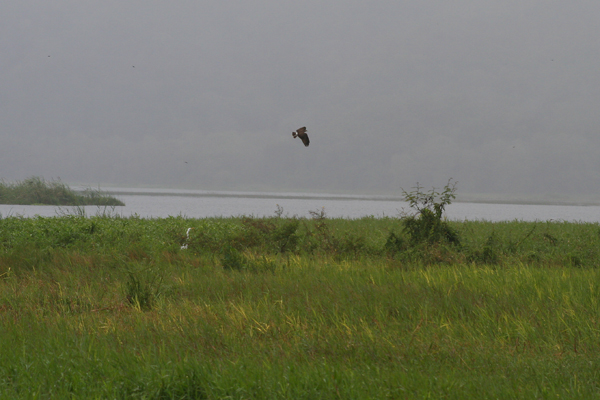
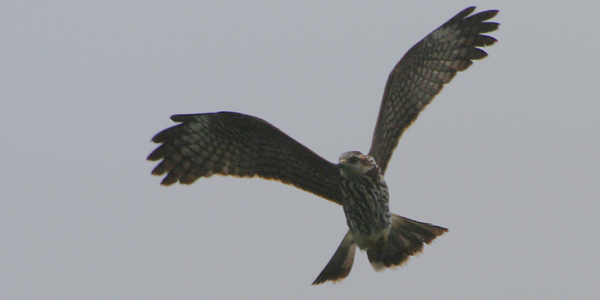
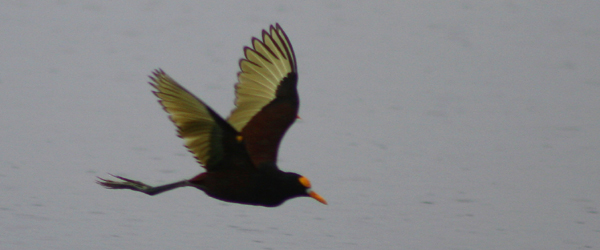
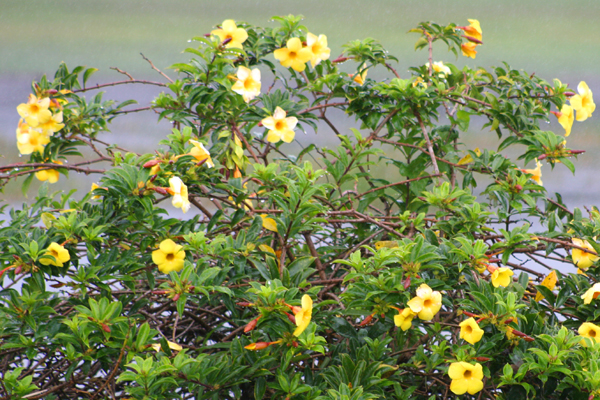
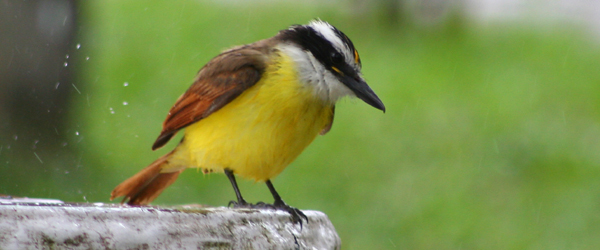










Is that a yellow warbler just down and to the right of the middle of shot?
The snail kite is very cool Corey but what’s the white thing in the top shot?
A couple years ago a vagrant Snail Kite managed to find its way up to South Carolina. It set up shop at a crayfish farm and put its bill to good use ripping up crawdads. So I guess in a pinch they’ll eat something other than snails, but that’s definitely an exception.
And I thought you just loved me for my Zicam. Just to let you know: birding with Corey is the bomb. We are well-matched in enthusiasm level (both our dials go to eleven.) Nice, nice shots, even in zero light and rain. Keep ’em coming!
@tai haku: Yes on the Yellow Warbler, and the white thing is a Great Egret (it’s in the rollover caption).
@Nate: Glad for the info…and that must have been pretty cool to watch.
@Julie: That zinc stuff sure helped my cold (I can’t believe I had a cold in the tropics!). And thanks! Now if we could just have gotten a Least Grebe to swim into view…
Corey,
Mary and I just got back from Utila yesterday and I am already jonesing for Honduras. i feel sure we will go back.
I have only read the first entry here of your blog on Honduras, am looking forward to the rest!
Great meeting you.
Bill
Yes, yes, yes – keep it coming. I’m starting to feel neotropical withdrawal symptoms and you, Julie, and Mke, are helping to keep my sanity.
Birding in the rains should be interesting and going by your experience it seems to be a quite eventful getting drenched in chilling rains.
I once did this (in Kabini wildlife sanctuary) and my experience was pretty frustrating. Not because the sightings were bad, it just that you are not able to produce quality images of the wildlife you see. In this case I saw a Leopard sheltering itself in the rain on a treetop but even at 1600 ISO the D300 refused to get me a usable shot.
@Bill: You’re not the only one wishing he was still there. And it was great meeting you as well!
@Christopher: Leaving the neotrops is good practice for when I (eventually) quit smoking.
@Thomas: The rain is not easy to shoot in at all. I had the ISO set pretty high and had several more decent photo opportunities that just came out poorly. Oh well, that’s why I carry binoculars too.
Hey, Corey, another fun blog piece on Honduras! Reading these is saving my life as I look out on Seattle snowfall. I am consoled by great memories of birding with the gang AND am suffering HonduWithdrawal along with what I’m sure is YOUR cold. Ah, the constant yin-and-yang of it all. You get my vote as the “Most fun guy to stand next to when he sees a life bird” person ever.
@Colene: I’m finally over the cold so you should be fine in, oh, about a week and a half or so…so sorry.
Thanks for the complement about the post and I guess you are probably an expert on seeing me seeing life birds seeing as I saw so many in your company!
I live an hour inland from Galveston, Texas and have a hawk circling my ducklings that I’ve never seen before. At first it appeared to be a large seagull, but I saw my ducklings get scared and upset. It started circling like a hawk and then came very close to us. It definitely was white on the under belly, a distinct split tail, and was a dark blue/grey on the top. It is a hawk, but I can’t find it on the internet. Do you know anything about Texas hawks?
@lillyanderson: I am by no means an expert on Texas raptors, having never been, but the split tail makes me think Swallow-tailed Kite, though the range maps I’ve looked at seem to indicate that this is unlikely. But try a google image search of Swallow-tailed Kite and see if its your bird…